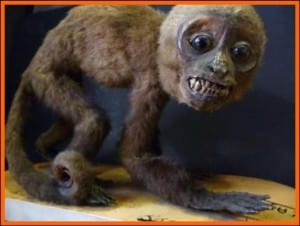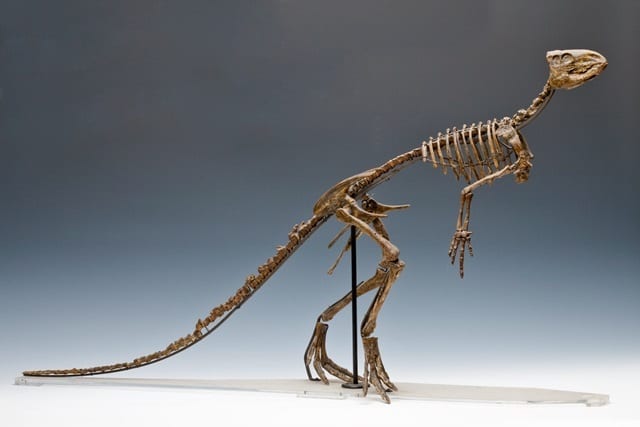Specimen of the Week: Week 176
By Mark Carnall, on 23 February 2015
A question we get from our visitors a lot at the Grant Museum is “Is it a dinosaur?” either preceded or followed by the question “Is it real?”. There’s something about a natural history museum that despite displaying skeletons of horses, rhinos, frogs, fish, bats, cats, rats, snakes and crocodiles, to many of our younger visitors (but not exclusively) any skeleton in a museum, particularly a big one, has to be a dinosaur (of the non bird variety of course but that’s a blog post for another time). That’s how dinosaurs come, as large skeletons. So unfortunately for us we have to deflate the expectations of our visitors sometimes by informing them that no, sorry, it isn’t a dinosaur it’s ‘just’ an elephant or gorilla or tiger. Animals which are endlessly fascinating and amazing in their own right but not at the precise moment of discovering “oh-its-not-a-dinosaur”.
We don’t have a huge amount of dinosaur material at the Grant Museum – just over one hundred specimens including a lot of plaster casts and our ever popular plastic dinosaur collection. Of the actual fossil material we have in the collection, there’s very little material which brings to mind the awe-inspiring, ground shaking, fearsome dinosaurs we’re used to in popular culture. The reality is (dare I say) a bit more underwhelming, our dinosaur fossil collection comprises fragments of ribs, partial vertebrae and according to one of our database entries a ‘sub angular fossil fragment’. However, we do have one complete (non-avian) dinosaur skeleton on display. One that’s easily missed, tucked above our whale display. So ask me again. Is it a dinosaur? Yes it is! Is it real? Errr no, it’s just a cast (topical) BUT IT’S STILL INTERESTING OKAY.
This week’s specimen of the week is…
** A Hypsilophodon foxii skeleton cast**
1) A TOWERING GIANT Frequent visitors to the Grant Museum may be thinking wow how did I miss this skeleton? Well what isn’t shown in the image here is the scale bar. This cast stands a mere 50cm high, a decidedly un-dinosaur size in the minds of many visitors. Hypsilophodon is a genus of dinosaur known only from the Cretaceous deposits on the Isle of Wight. Hypsilophodon was a small bipedal dinosaur equipped with a beak and was probably herbivorous although some have suggested it may have been an omnivore.
2) The Nature of the Beast Hypsilophodon was discovered early on in the history of dinosaur palaeontology, in 1849 less than a decade after anatomist Richard Owen coined the name dinosaur. Since then there has been a lot of interpretation and reinterpretation on what kind of animal Hypsilophodon actually was. Initially it was interpreted as the remains of, another early dinosaur, a young Iguanodon by palaeontologists Gideon Mantell and Richard Owen. It wasn’t until 1870 that Thomas Henry Huxley described Hypsilophodon as a separate genus and it’s own animal. Since then, interpretations and research around Hypsilophodon have changed a lot. As a child I remember reading about and seeing reconstructions of Hypsilophodon as an armoured tree dwelling animal, a theory initially suggested in the 1880s (I’m not that old) and not convincingly debunked until the 1970s. There have also been a number of dinosaur remains from across Europe and in America which have been described as Hypsilophodon but, for the time being, they have all been determined as different dinosaurs or material which isn’t diagnostic enough to attribute it accurately.
3) Type Cast I had always assumed that the Grant Museum specimen was a cast of the skeleton at the Natural History Museum London, specimen number NHM R5830 as seen in this image here, however, looking at it now the shape of the skull on our cast looks very different. If any palaeontologists out there recognise this skeleton then please do leave a comment below. Unsurprisingly, we don’t currently have any information about when this specimen came into the Grant Museum. It isn’t listed in our 1898 catalogue of the collection which is annotated with additions to the collections up until the 1910s. It’s possible that this came from one of the many collections that came to UCL when other university collections were closed down in the 1970s and 1980s.
4) Foxii Beast When Huxley named this dinosaur he chose the name foxii after Reverand William Fox. William Fox, a curate at a parish on the Isle of Wight. A keen collector, Fox discovered a number of remains on the Isle of Wight of dinosaurs that he brought to the attention of anatomists like Richard Owen who subsequently named the new dinosaurs in honour of the benevolent collector.
5) Tales from the Field As a student at the University of Portsmouth I was very lucky to get some summer fieldwork on the Isle of Wight for a TV show called Live From Dinosaur Isle – a brave live palaeontological programme. I was part of the team working with Dr David Martill at a site where we would be uncovering the extension of geological beds where Hypsilophodon remains had been found by Fox himself. The reason why the programme was brave is because fieldwork rarely pans out as you’d expect it to but the premise of the show was that as the week rolled on various teams across the Isle of Wight would be discovering dinosaur remains. As the week progressed and (much to the frustration of the show producers), it transpired that the ‘hundreds of Hypsilophodon remains’ we’d hoped to be excavating must have chosen somewhere else to die and get buried. The most significant find from the site I was working was a pterosaur tooth that presenter Bill Oddie happened to pick up in between takes. I’m not sure if this programme exists anywhere on the Internet today but if it does you might spot a much younger me ‘hammering quietly’ in the background.
Mark Carnall is the Curator of the Grant Museum of Zoology
3 Responses to “Specimen of the Week: Week 176”
- 1
-
2
Lorna Steel wrote on 10 March 2015:
there’s some information about the series here:
http://h2g2.com/edited_entry/A664661 -
3
James wrote on 29 September 2015:
my 11 year old daughter found this article and asked me to read to her…lol she loves dinosaurs. thank you!
 Close
Close




I was also on Live from Dinosaur Island, ‘hammering quietly’ in the background. I think the ill-judged comment from Dave Martill was that there would be 5000 Hypsilophodons in the Hypsilophodon Bed. He still gets teased about that now, 15 years on. Wonder what happened to the pterosaur tooth? Each of the four sites (Iguanodon, Hypsilophodon, Neovenator and sauropod) had its own colourful sign with a dinosaur skeleton, and these signs are still displayed at Dinosaur Isle. BBC threw a great party at the end too.